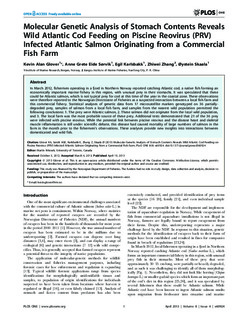Molecular Genetic Analysis of Stomach Contents Reveals Wild Atlantic Cod Feeding on Piscine Reovirus (PRV) Infected Atlantic Salmon Originating from a Commercial Fish Farm
Journal article, Peer reviewed
Permanent lenke
http://hdl.handle.net/11250/109292Utgivelsesdato
2013-04-19Metadata
Vis full innførselSamlinger
- Articles [3001]
Originalversjon
http://dx.doi.org/10.1371/journal.pone.0060924Sammendrag
In March 2012, fishermen operating in a fjord in Northern Norway reported catching Atlantic cod, a native fish forming an economically important marine fishery in this region, with unusual prey in their stomachs. It was speculated that these could be Atlantic salmon, which is not typical prey for cod at this time of the year in the coastal zone. These observations were therefore reported to the Norwegian Directorate of Fisheries as a suspected interaction between a local fish farm and this commercial fishery. Statistical analyses of genetic data from 17 microsatellite markers genotyped on 36 partially-degraded prey, samples of salmon from a local fish farm, and samples from the nearest wild population permitted the following conclusions: 1. The prey were Atlantic salmon, 2. These salmon did not originate from the local wild population, and 3. The local farm was the most probable source of these prey. Additional tests demonstrated that 21 of the 36 prey were infected with piscine reovirus. While the potential link between piscine reovirus and the disease heart and skeletal muscle inflammation is still under scientific debate, this disease had caused mortality of large numbers of salmon in the farm in the month prior to the fishermen's observations. These analyses provide new insights into interactions between domesticated and wild fish.
